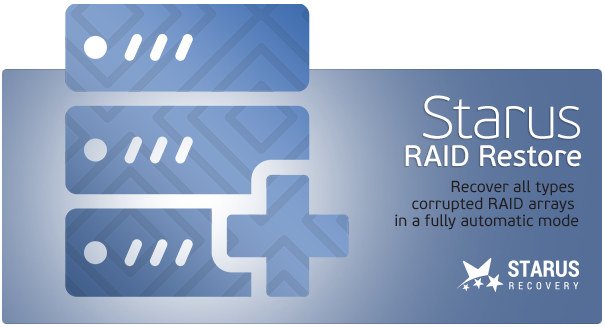
Starus RAID Restore
Starus RAID Restore : This utility recovers data from faulty RAID configurations or disks within such configurations. It reads out every piece of data on the controller, motherboard or software used to construct a disk array. Our software can reconstruct the broken RAID and it lets you copy all crucial information from there.
The in-built constructor wizard helps you restore a failed RAID in step-by-step mode. You can use one of the presets or choose the required data in the failed array, and RAID Recovery™ will combine the disks into a single to provide you with access to the data.
Feature of Starus RAID Restore
Why RAID gets damaged
Retrieve any kind of JBOD, RAID 0, RAID 1, RAID 10, RAID 5, RAID 50, RAID 6, RAID 60, etc. hardware or software RAID.
Hard disk failure
HDD and SSD types of hard disks have a limited life for operation. Naturally, server-grade NAS or SCSI disks can last years more than the SATA disks that are to be used at home only, but there’s no hard disk that runs perpetually. For most RAID arrays, the day a single or double disk failure occurs means loss of all the data, from each disk within this array. The dependability of the whole array decreases with every disk that belongs to it.
Accidental array rebuilding
Mistakes in swapping one of the disks within the storage system, accidental “rebuilding” instead of “restoring” the array, removing and reinstalling the disks in the wrong order, incorrect RAID initialization or rebuild – all of these will surely result in data loss. Once these kinds of mistakes happen, RAID can no longer automatically recover.
A controller bug or failure
A controller is the part storing information of highest importance that is critical for building a disk array and accessing all files on the disks. Controller failure can both result in data loss of service as well as trigger multiple disk failures. The most expensive controllers use an extra battery and non-volatile memory. These units make the whole system more reliable and are built to store data even in case of a power failure.
A motherboard failure
Creating a RAID with specific motherboard support is a cheaper (though less reliable) option than buying an expensive controller. Motherboard crashes, broken BIOS updates, dead CMOS battery, power surges, disk disconnection or reconnection – all these can cause your RAID to crash. Because the whole system is very sensitive to any form of power issues, power supply unit failures will also cause crashes.
A system crash
Software RAID systems based on an operating system – Windows, macOS, Linux, FreeBSD, Ubuntu – are highly dependent on the state of the operating system. Hardware upgrade, or software upgrade can cause errors that make the computer incapable of booting and make data in such array inaccessible.
In contrast to hardware RAID configurations, the arrays based on software consist of logical partitions rather than physical disks. Partition or unpartition operations can rather easily destroy such array.
What’s new
- official site is not providing any details about change in this version
Editions: Home, Office, Commercial, Unlimited

Comments are closed.